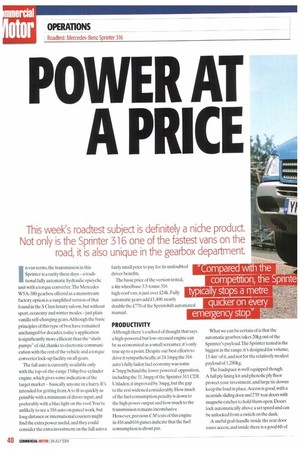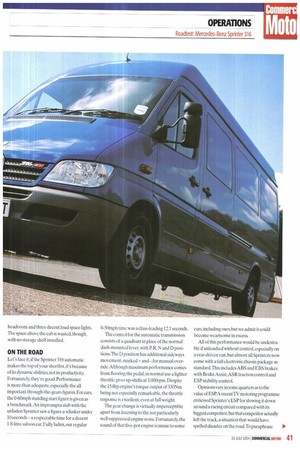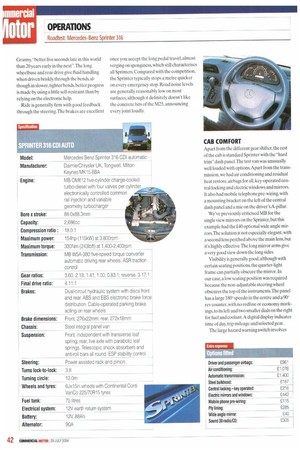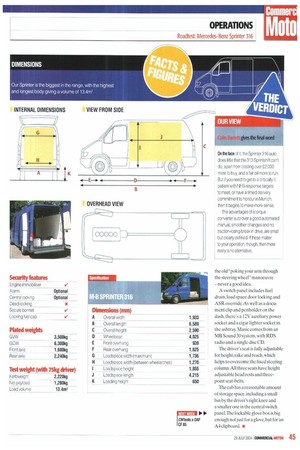POWER AT A PRICE
Page 40

Page 41

Page 42

Page 45

If you've noticed an error in this article please click here to report it so we can fix it.
This week's roadtest subject is definitely a niche product Not only is the Sprinter 316 one of the fastest vans on the road, it is also unique in the gearbox department
11 n van terms, the transmission in this Sprinter is a rarity these days a traditional fully automatic hydraulic epicyclic unit with a torque converter.The Mercedes W5A-380 gearbox offered as a mainstream factory option is a simplified version of that found in the S Class luxury saloon, but without sport, economy and winter modes -just plain vanilla self-changing gears. Although the basic principles of this type of box have remained unchanged for decades, today's application is significantly more efficient than the "slush pumps" of old, thanks to electronic communication with the rest of the vehicle and a torque converter lock-up facility on all gears.
The full auto is currently available only with the top-of-the-range 154hp five-cylinder engine. which gives some indication of the target market basically anyone in a hurry It's intended for getting from A to B as quickly as possible with a minimum of driver input, and preferably with a blue light on the roof.You're unlikely to see a 316 auto on parcel work, but long distance or international couriers might find the extra power useful, and they could consider the extra investment on the full auto a fairly small price to pay for its undoubted driver benefits.
The basic price of the version tested, a 4m wheelbase 3.5-tonne 316 high-roof van, is just over £24k. Fully automatic gears add £1,400.nearly double the £770 of the Sprintshift automated manual.
PRODUCTIVITY Although there's a school of thought that says a high-powered but low-stressed engine can be as economical as a small screamer, it's only true up to a point. Despite our best efforts to drive it sympathetically, at 24.Impg the 316 auto's fully laden fuel economy was some 4-7mpg behind the lower powered opposition, including the 31.3mpg of the Sprinter 311 CDI. Unladen. it improved by 3mpg, but the gap to the rest widened considerably. How much of the fuel consumption penalty is down to the high power output and how much to the transmission remains inconclusive.
However, previous CM tests of this engine in 416 and 616 guises indicate that the fuel consumption is about par. What we can be certain of is that the automatic gearbox takes 20kg out of the Sprinter's payload.The Sprinter tested is the biggest in the range: it's designed for volume, 13.4m3 of it, and not for the relatively modest payload of 1,280kg.
The loadspace is well equipped though. A full ply lining kit and phenolic ply floor protect your investment, and large tie downs keep the load in place.Access is good, with a nearside sliding door and 270' rear doors with magnetic catches to hold them open. Doors lock automatically above a set speed and can be unlocked from a switch on the dash.
A useful grab handle inside the rear door eases access, and inside there is a good 6ft of headroom and three decent load space lights. The space above the cab is wasted, though, with no storage shelf installed.
ON THE ROAD
Let's face it, if the Sprinter 316 automatic makes the top of your shortlist, it's because of its dynamic abilities, not its productivity. Fortunately, they're good. Performance is more than adequate, especially the all important through-the-gears figures. For cars, the 0-60mph standing start figure is given as a benchmark.An impromptu stab with the unladen Sprinter saw a figure a whisker under 10 seconds — a respectable time for a decent 1.8-litre saloon car. Fully laden, our regular 0-50mph time was a class-leading 12.1 seconds.
The control for the automatic transmission consists of a quadrant in place of the normal dash-mounted lever, with P,R,N and D positions.The D position has additional sideways movement. marked + and -,for manual override.Although maximum performance comes from flooring the pedal, in normal use a lighter throttle gives up-shifts at 3,000rpm. Despite the 154hp engine's torque output of 330Nm being not especially remarkable,the throttle response is excellent, even at full weight.
The gear change is virtually imperceptible apart from listening to the not particularly well suppressed engine noise. Fort unately, the sound of that five-pot engine is music to some ears, including ours, but we admit it could become wearisome in excess.
All of this performance would be undesirable if unleashed without control.especially on a rear-driven van, but almost all Sprinters now come with a full electronic chassis package as standard.This includes ABS and EBS brakes with Brake Assist .ASR traction control and ESP stability control.
Opinions vary in some quarters as to the value of ESP.A recentTV motoring programme criticised Sprinter's ESP for slowing it down around a racing circuit compared with its biggest competitor. but that competitor actually left the track, a situation that would have spelled disaster on the road.To paraphrase ■ Granny,"better five seconds late in this world than 20 years early in the next". The long wheelbase and rear drive give fluid handling when driven briskly through the bends, although in slower, tighter bends, better progress is made by using a little self-restraint than by relying on the electronic help.
Ride is generally firm with good feedback through the steering. The brakes are excellent once you accept the long pedal travel, almost verging on sponginess, which still characterises all Sprinters. Compared with the competition, the Sprinter typically stops a metre quicker on every emergency stop. Road noise levels are generally reasonably low on most surfaces, although it definitely doesn't like the concrete bits of the M25. announcing every joint loudly. CAB COMFORT Apart from the different gear shifter, the rest of the cab is standard Sprinter with the "hard trim" dash panel.The test van was unusually well loaded with options. Apart from the transmission, we had air conditioning and residual heat restore, airbags for all,key-operated central locking and electric windows and mirrors. It also had mobile telephone pre-wiring, with a mounting bracket on the left of the central dash panel and a mic on the driver's A-pillar.
We've previously criticised MB for the single view mirrors on the Sprinter, but this example had the £40 optional wide angle mirrors.The solution is not especially elegant, with a second lens perched above the main lens,but it's highly effective.The long mirror arms give a very good view down the long sides.
Visibility is generally good, although with certain seating positions. the quarter-light frame can partially obscure the mirror. In our case, a low seating position was required because the non-adjustable steering wheel obscures the top of the instruments.The panel has a large 180" speedo in the centre and a 90" rev counter, with no redline or economy markings, to its left and two smaller dials on the right for fuel and coolant.A digital display indicates time of day.trip mileage and selected gear.
The large hazard warning switch involves the old "poking your arm through the steering wheel" manoeuvre —never a good idea.
A switch panel includes fuel drain, load space door locking and ASR override. As well as a document clip and penholder on the dash, there's a12V auxiliary power socket and a cigar lighter socket in the ashtray. Music comes from an MB Sound 30 system, with RDS radio and a single disc CD.
The driver's seat is fully adjustable for height, rake and reach, which helps to overcome the fixed steering column.All three seats have height adjustable head rests and threepoint seat-belts.
The cab has a reasonable amount of storage space. including a small bin by the driver's right knee and a smaller one in the central switch panel .The lockable glove box is big enough not just for a glove, but for an A4 clipboard. I


















































































































































































